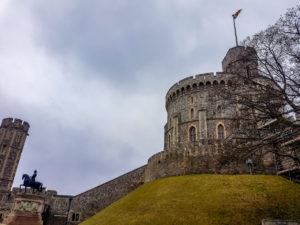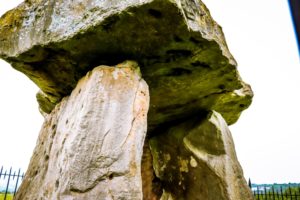Warwick Castle is a medieval castle developed from a wooden fort, originally built by William the Conqueror during 1068. Warwick is the county town of Warwickshire, England, situated on a meander of the River Avon. The original wooden motte-and-bailey castle was rebuilt in stone during the 12th century. During the Hundred Years War, the facade opposite the town was refortified, resulting in one of the most recognizable examples of 14th-century military architecture. It was used as a stronghold until the early 17th century when it was granted to Sir Fulke Greville by James I in 1604. Greville converted it to a country house, and it was owned by the Greville family (who became Earls of Warwick in 1759) until 1978.
Antecedent
An Anglo-Saxon burh was established on the site in 914; with fortifications instigated by Æthelflæd, daughter of Alfred the Great. The burh she established was one of ten that defended Mercia against the invading Danes. Its position allowed it to dominate the Fosse Way, as well as the river valley and the crossing over the River Avon. Though the motte to the south-west of the present castle is now called “Ethelfleda’s Mound” (‘Ethelfleda’ being an alternative form of Æthelflæd), it is in fact part of the later Norman fortifications, and not of Anglo-Saxon origin.
After the Norman conquest of England, William the Conqueror established a motte-and-bailey castle at Warwick in 1068 to maintain control of the Midlands as he advanced northwards. Building a castle in a pre-existing settlement could require demolishing properties on the intended site. In the case of Warwick, the least recorded of the 11 urban castles in the 1086 survey, four houses were torn down to make way for the castle. A motte-and-bailey castle consists of a mound – on which usually stands a keep or tower – and a bailey, which is an enclosed courtyard. William appointed Henry de Beaumont, the son of a powerful Norman family, as constable of the castle. In 1088, Henry de Beaumont was made the first Earl of Warwick. He founded the Church of All Saints within the castle walls by 1119; the Bishop of Worcester, believing that a castle was an inappropriate location for a church, removed it in 1127–28.
In 1153, the wife of Roger de Beaumont, 2nd Earl of Warwick, was tricked into believing that her husband was dead, and surrendered control of the castle to the invading army of Henry of Anjou, later King Henry II of England. According to the Gesta Regis Stephani, a 12th-century historical text, Roger de Beaumont died upon hearing the news that his wife had handed over the castle. King Henry II later returned the castle to the Earls of Warwick, as they had been supporters of his mother, Empress Matilda, in The Anarchy of 1135–1154









